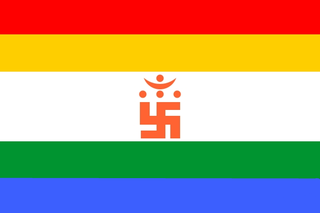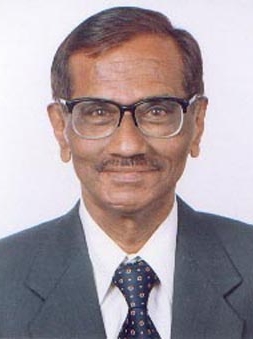
Hindus are people who religiously adhere to Hinduism, also known by its endonym Sanātana Dharma. Historically, the term has also been used as a geographical, cultural, and later religious identifier for people living in the Indian subcontinent.

Indian religions, sometimes also termed Dharmic religions or Indic religions, are the religions that originated in the Indian subcontinent. These religions, which include Buddhism, Hinduism, Jainism, and Sikhism, are also classified as Eastern religions. Although Indian religions are connected through the history of India, they constitute a wide range of religious communities, and are not confined to the Indian subcontinent.
The Uniform Civil Code is a proposal in India to formulate and implement personal laws of citizens which apply on all citizens equally regardless of their religion. Currently, personal laws of various communities are governed by their religious scriptures. Personal laws cover marriage, divorce, inheritance, adoption and maintenance. While articles 25-28 of the Indian Constitution guarantee religious freedom to Indian citizens and allow religious groups to maintain their own affairs, article 44 expects the Indian state to apply directive principles and common law for all Indian citizens while formulating national policies.

In the field of comparative religion, many scholars, academics, and religious figures have looked at the relationships between Hinduism and other religions.

The Dalit Buddhist movement is a religious as well as a socio-political movement among Dalits in India which was started by B. R. Ambedkar. It re-interpreted Buddhism and created a new school of Buddhism called Navayana. The movement has sought to be a socially and politically engaged form of Buddhism.
Freedom of religion in India is a fundamental right guaranteed by Article 25–28 of the Constitution of India. Modern India came into existence in 1947 and the Indian constitution's preamble was amended in 1976, to explicitly declare India a secular state. Supreme Court of India ruled that India was already a secular state from the time it adopted its constitution, what actually was done through this amendment is to state explicitly what was earlier contained implicitly under article 25 to 28. Every citizen of India has a right to practice and promote their religion peacefully. However, there have been numerous instances of religious intolerance that resulted in riots and mob violences; notably, the 1984 Sikh Massacre in and around Delhi, 1990 Exile of Kashmiri Pandits (Brahmins) from Kashmir (Cashmere), the 1992–93 Bombay Riots in Mumbai (Bombay), the 2008 Anti-Christian riots in Odisha (Orissa) and other anti-Christian violence in India. Some perpetrators of the 1984 Sikh Massacre have not been brought to justice despite widespread condemnation.
Sampradaya, in Indian origin religions, namely Hinduism, Buddhism, Jainism, and Sikhism, can be translated as 'tradition', 'spiritual lineage', 'sect', or 'religious system'. To ensure continuity and transmission of dharma, various sampradayas have the Guru-shishya parampara in which parampara or lineage of successive gurus (masters) and shishyas (disciples) serves as a spiritual channel and provides a reliable network of relationships that lends stability to a religious identity. Shramana is vedic term for seeker or shishya. Identification with and followership of sampradayas is not static, as sampradayas allows flexibility where one can leave one sampradaya and enter another or practice religious syncretism by simultaneously following more than one sampradaya. Samparda is a Punjabi language term, used in Sikhism, for sampradayas.
The Gujarat Freedom of Religion Act (2003) requires religious conversions in Gujarat, India, to be approved by a district magistrate.

Jainism is India's sixth-largest religion and is practiced throughout India. Per the 2011 census, there are 4,451,753 Jains in the 1.35 billion population of India, the majority living in Maharashtra, Rajasthan, Gujarat, Madhya Pradesh and Karnataka. However, the influence of Jainism has been far greater on the Indian population than these numbers suggest. Jains can be found in every state and all union territories, varying from large societies to smaller. The state of Jharkhand, with a population of 16,301 Jains also contains the holy pilgrimage centre of Sammed Shikharji. Jains can be found throughout India and in many other countries throughout the world.

Since its independence in 1947, India has accepted various groups of refugees from neighbouring countries, including partition refugees from former British Indian territories that now constitute Pakistan and Bangladesh, Tibetan refugees that arrived in 1959, Chakma refugees from present day Bangladesh in early 1960s, other Bangladeshi refugees in 1965 and 1971, Sri Lankan Tamil refugees from the 1980s and most recently Rohingya refugees from Myanmar. In 1992, India was seen to be hosting 400,000 refugees from eight countries. According to records with the Union Ministry of Home Affairs, as on January 1,2021, there were 58,843 Sri Lankan refugees staying in 108 refugee camps in Tamil Nadu and 54 in Odisha and 72,312 Tibetan refugees have been living in India.

Religion in India is characterised by a diversity of religious beliefs and practices. Throughout India's history, religion has been an important part of the country's culture and the Indian subcontinent is the birthplace of four of the world's major religions, namely, Buddhism, Hinduism, Jainism, and Sikhism, which are collectively known as native Indian religions or Dharmic religions and represent approx. 83% of the total population of India.
The United Nations categorizes Bangladesh as a moderate democratic Muslim country. Sunni Islam is the largest religion in the country and in all of its districts, except Rangamati. The Constitution of Bangladesh refers to Islam twice: the document begins with the Islamic phrase Bismillahir Rahmanir Raheem and article (2A), added later, declares that: "Islam is the state religion of the republic".
Jainism is an ancient Indian religion belonging to the śramaṇa tradition. It prescribes ahimsa (non-violence) towards all living beings to the greatest possible extent. The three main teachings of Jainism are ahimsa, anekantavada (non-absolutism), aparigraha (non-possessiveness). Followers of Jainism take five main vows: ahimsa, satya, asteya, brahmacharya (chastity), and aparigraha. Monks follow them completely whereas śrāvakas (householders) observe them partially. Self-discipline and asceticism are thus major focuses of Jainism.
Hinduism is the most followed religion in Bihar, followed by nearly 82% of total population as per 2023 Bihar Caste based census. Islam is the second-most followed religion which is followed by nearly 17.7% of population. There is also a significant population of Buddhists and Christians in the state.
Modern Hindu law is one of the personal law systems of India along with similar systems for Muslims, Sikhs, Parsis, and Christians. This Hindu Personal Law or modern Hindu law is an extension of the Anglo-Hindu Law developed during the British colonial period in India, which is in turn related to the less well-defined tradition of Classical Hindu Law. The time frame of this period of Hindu law begins with the formal independence of India from Great Britain on August 14, 1947, and extends up until the present. While modern Hindu law is heralded for its inherent respect for religious doctrines, many still complain that discrimination still pervades the legal system, though efforts to modernize and increase the legal rights of the marginalized have been made.

Vishva Hindu Parishad (VHP) is an Indian right-wing Hindu organisation based on Hindu nationalism. The VHP was founded in 1964 by M. S. Golwalkar and S. S. Apte in collaboration with Swami Chinmayananda. Its stated objective is "to organise, consolidate the Hindu society and to serve and protect the Hindu Dharma". It was established to construct and renovate Hindu temples, and deal with matters of cow slaughter and religious conversion. The VHP is a member of the Sangh Parivar group, the family of Hindu nationalist organisations led by the RSS.
Religion in the Punjab in ancient history was characterized by Hinduism and later conversions to Jainism, Buddhism, Islam, Sikhism and Christianity; it also includes folk practices common to all Punjabis regardless of the religion they adhere to. Such practices incorporate local mysticism, including ancestral worship and worship of local saints of all faiths.

Bal Patil was a Jain scholar, journalist, social activist and Jain minority status advocate from Mumbai, Maharashtra. He was appointed as a member of State Minority Commission by the Govt. of Maharashtra from 2001 to 2004. He was the Secretary-General of All India Jain Minority Forum, New Delhi—a position he held until his death—and was an ardent advocate of minority status for Jainism. The Jain minority cause gained prominence when he petitioned the Supreme Court of India for the recognition of Jain religious minority status on par with other Indian minorities as per the two recommendations by the National Minorities Commission. He was also the first non-medical President of the National Society for the Prevention of Heart Disease & Rehabilitation, Mumbai. He has also authored many books on Jainism and presented several papers at various seminars and conferences.
Religion in Maharashtra is characterised by the diversity of religious beliefs and practices.










